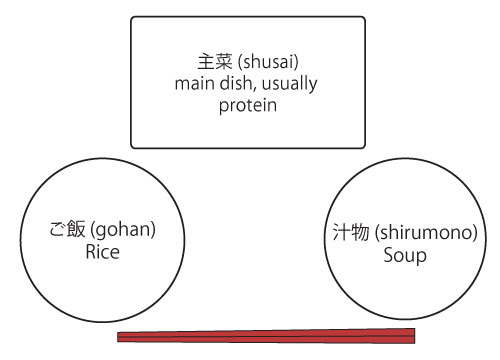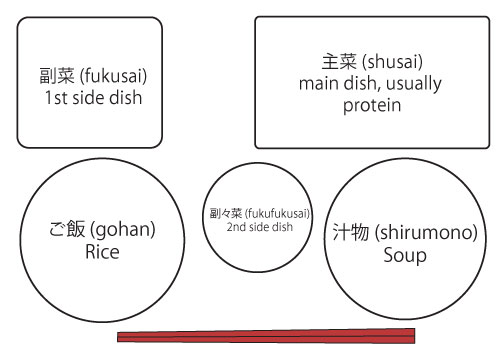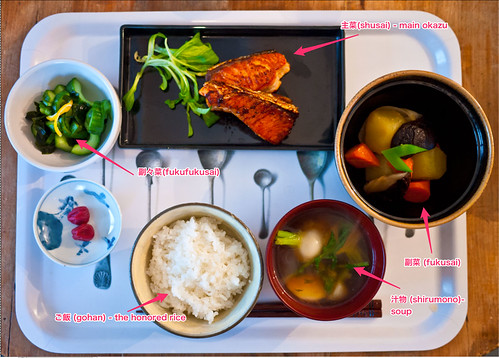Japanese Cooking 101, Lesson 6: Putting It All Together
Welcome to the last lesson in Japanese 101: The Fundamentals of Washoku. I hope you've enjoyed the course and learned a few things along the way. In this last lesson we'll take a look back at what we've learned, and also see how to put it all together to great an authentic traditional Japanese meal at home.
What we've covered in this course
First we looked at the basic pantry ingredients for the course, which are also the basic pantry ingredients for a traditional Japanese kitchen.
Then learned how to make proper dashi stock, which is the foundation of many savory dishes in Japanese cooking. We also learned how to make miso soup and clear soup using that good dashi stock.
Next, we took a good hard look at how to prep and cook Japanese style rice. Rice is central to Japanese life, not to mention most Japanese meals. We also learned how to make sushi rice.
Then we got to the dishes that go with the rice and soup, starting with nimono or simmered dishes (even without dashi). We went on to sunomono and aemono - basically prepped or precooked vegetables with some kind of sauce.
We then ended by looking in-depth at arguably the most important protein used in Japanese cooking, fish, from a simple teriyaki to whole fish opened up to breaking down whole small fish and using every part of it.
If you missed the course by the way, just follow the links in the paragraph above in sequence! Or, just start at the very beginning intro, then go to the first article linked below that, required ingredients. After that just keep clicking on the 'next' article link below each article.
There was actually a logic to this...
There's a reason why I presented the parts of the course in the order I did:
- Dashi is so fundamental to traditional Japanese cuisine that it's important to know how to make it and how to use it. This way of thinking - flavoring something with a little umami - permeates other types of cooking in Japan too.
- Soup also is a part of most meals, even breakfast.
- Rice forms the center of most Japanese meals. Sure, sometimes we deviate and have some noodles or something else, But we keep going back to rice. The word for cooked rice, gohan (ご飯)is also used to indicate the whole meal. When mom called out "gohan dayo-" when we were out playing, we knew she meant "it's dinner time", not just "it's rice". Even if that bowl of rice was not always 100% - poor people often had to mix in other grains like barley or millet - the ideal was always that plain bowl of white rice. (Ironicly of course these days people mix in these zakkoku (雑穀), the 'other grains' formerly looked down upon, into rice for their nutritious benefits. See more about zakkoku-mai or mixed grains with rice.)
- The other dishes are basically side dishes to the rice. In Western style cooking, the main protein is the 'star' of the meal, but in Japan the rice is the unquestioned king of the table. Everything else on the table is judged by how well it goes with that plain bowl of rice. The word for all of these side dishes is okazu (おかず)__, or more formally, fukusai (副菜).
The one-soup, three-side dish rule
A balanced Japanese meal is supposed to have__ 一汁三菜 - ichijuu sannsai - 1 soup, 3 side dishes, to go with the rice. It may sound like a lot, but it's not that much more than many western style meals if you think about it. A typical western meal might have a soup as a starter, then a main dish with steak, potatoes, and some side vegetable like steamed broccoli, followed by a sweet dessert. A traditional Japanese meal doesn't have separate courses - everything is served at once. (This differs at top end Japanese ryoutei or kaiseki restaurants, who often serve single dishes one at a time in multiple course.) Having more than 3 sides is extravagant, although in the olden days people avoided having 4 sides since the number 4 is unlucky in Japanese culture. (4 can be read as "yon" or "shi", and "shi is synonymous with 死, or death. Most Japanese buildings don't have a 4th floor, just like most Western buildings don't have a 13th floor.)
The bare basic Japanese meal is 一汁一菜 - ichijuu issai - 1 soup, 1 side dish, plus the bowl of rice.
(Incidentally, there's also no tradition of having dessert with a meal, which may be why many Japanese main dishes have a bit of sugar in them. Sweets are eaten separately during the day, not with a meal. This is changing, and many people have some fruit or a light dessert after a meal, but that is a recent thing influenced by western style eating.)
How to line up all those dishes
Traditional Japanese meals are served in multiple serving containers, one for each item. And there are some basic rules to follow as to how to line them up.
Here's how to line up a basic 一汁一菜 - ichijuu issai - 1 soup, 1 side dish, bowl of rice meal.

As you can see, the rice goes on the left, the soup on the right, and the side dish is behind that. The rice always goes on the left, even for lefties. That left corner closest to the diner is considered to be the most 'honorable' position (don't ask me why it's honorable...) so that's where it goes. If you think about it it it's not the most convenient way to arrange things for a right handes person, who'd have to reach over the soup to get to the rice. Maybe this is why you usually lift up your rice bowl and your soup bowl to eat from them. (You don't life up the other serving dishes though.)
This is how the full 一汁三菜 - ichijuu sannsai - 1 soup, 3 side dishes and rice meal is arranged.

There are no rules really to dictate where the side dishes go in relation to each other. But again, the rice and soup are closest to the diner, with the rice on the left. Plus, the main fukusai or side dish is in the most prominent position.
I arranged the dishes we made during the course for dinner one day following these rules. (Click on the photo to see a larger version.)
The little dish of umeboshi is not really considered to be a proper side dish so you can ignore that, but as you can see the rice is on the left, soup on the right, and the side dishes beyond that. As I mentioned in the salmon teriyaki chapter for fish, the skin side goes on the top or the far side; the same goes for a piece of skin-on chicken for example. If you are serving a whole fish the head goes to the left.
Flavor balance is important too
When you put a Japanese meal together, pay attention to the balance of flavors and cooking methods. Ideally you should aim for 1 yakimono (焼き物), something cooked with dry heat - grilled, pan-fried, or deep fried; 1 nimono (煮物), something simmered, and 1 aemono (和え物) or sunomono (酢の物) - a cold dish with a sauce, dashi based or vinegar based. This gives a good balance of flavors and textures. While the yakimono is usually a protein, the two other sides can be all-vegetable, or contain a little protein (e.g. a little seafood), and so forth.
In practice, on an everyday basis most families would have maybe 2 side dishes plus some pickles or something. But this is the ideal anyway. And it's not impossible to achieve since many dishes can be prepared in some bulk in advance, especially the nimono. What makes things a little easier for the cook when preparing Japanese food is that not everything has to be piping hot. The soup certainly should be, and the rice should be freshly cooked and hot too. And some yakimono or protein dishes should be too. But the side dishes to round out the meal don't need to be.
There are a lot of recipes on the site that you can use for any of these categories. Take a look!
Wrapping things up
So how was that walk through the basics of washoku, traditional Japanese cuisine? I hope it was interesting.
For people who were looking forward to more fish lessons, I've decided to hold off on them for a bit and possibly put them in a more advanced course down the line. Stay tuned!
I'm also planning at least one more 'course' series like this this year, but I'm still open to ideas about what it should be about. If you have some ideas please tell me in the comments.
Filed under: japanese washoku japanese culture japanesecooking101